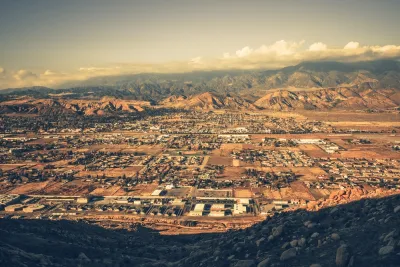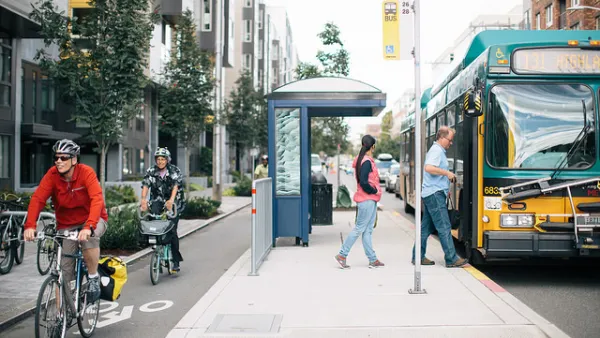No, this is not a trick question. By definition, you'd think the answer is L.A., where the heat is generated, but it's actually San Bernardino, 56 miles to the east. Turns out that like ozone, heat is transported by the wind.

"Heat islands are created by a combination of heat-absorptive surfaces (such as dark pavement and roofing), heat-generating activities (such as engines and generators), and the absence of vegetation (which provides evaporative cooling)," according to the Urban Heat Island Index for California from the California Environmental Protection Agency (CalEPA).
Using the new index which tracks temperatures across the state, CalEPA found that "[t]he highest temperatures crop up east of downtown Los Angeles and are pushed into the inland valley by ocean breezes," writes Sanden Totten, science reporter for KPCC. [Listen here]
"In that way we found that the urban heat island effect in the L.A. area really mimicked the ozone pollution problem in L.A. where it moved east and settles against the hills," said Gina Solomon, Deputy Secretary for Science and Health with CalEPA.
She adds that the index, a result of 2012 legislation (AB 296, Chapter 667, Statutes of 2012), is a way of "quantifying the urban heat island effect." It "is designed so that cities can have a quantifiable goal for heat reduction," according to the webpage.
"We call it not an urban heat island but an urban heat archipelago because it's like a whole chain of urban heat islands that run into each other," Solomon said.
“The Urban Heat Island Index offers state and local governments a tool to help prioritize areas for programs that reduce heat in urban communities, such as urban greening projects and cooler roofs and pavements," notes the press release.
FULL STORY: LA area has highest urban heat island effect in California

National Parks Layoffs Will Cause Communities to Lose Billions
Thousands of essential park workers were laid off this week, just before the busy spring break season.

Retro-silient?: America’s First “Eco-burb,” The Woodlands Turns 50
A master-planned community north of Houston offers lessons on green infrastructure and resilient design, but falls short of its founder’s lofty affordability and walkability goals.

Delivering for America Plan Will Downgrade Mail Service in at Least 49.5 Percent of Zip Codes
Republican and Democrat lawmakers criticize the plan for its disproportionate negative impact on rural communities.

Test News Post 1
This is a summary

Test News Headline 46
Test for the image on the front page.

Balancing Bombs and Butterflies: How the National Guard Protects a Rare Species
The National Guard at Fort Indiantown Gap uses GIS technology and land management strategies to balance military training with conservation efforts, ensuring the survival of the rare eastern regal fritillary butterfly.
Urban Design for Planners 1: Software Tools
This six-course series explores essential urban design concepts using open source software and equips planners with the tools they need to participate fully in the urban design process.
Planning for Universal Design
Learn the tools for implementing Universal Design in planning regulations.
EMC Planning Group, Inc.
Planetizen
Planetizen
Mpact (formerly Rail~Volution)
Great Falls Development Authority, Inc.
HUDs Office of Policy Development and Research
NYU Wagner Graduate School of Public Service





























